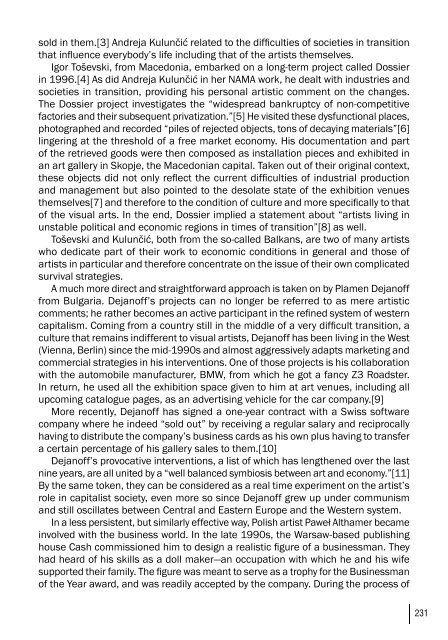art-e-conomy _ reader - marko stamenkovic
art-e-conomy _ reader - marko stamenkovic
art-e-conomy _ reader - marko stamenkovic
You also want an ePaper? Increase the reach of your titles
YUMPU automatically turns print PDFs into web optimized ePapers that Google loves.
sold in them.[3] Andreja Kulunčić related to the difficulties of societies in transition<br />
that influence everybody’s life including that of the <strong>art</strong>ists themselves.<br />
Igor Toševski, from Macedonia, embarked on a long-term project called Dossier<br />
in 1996.[4] As did Andreja Kulunčić in her NAMA work, he dealt with industries and<br />
societies in transition, providing his personal <strong>art</strong>istic comment on the changes.<br />
The Dossier project investigates the “widespread bankruptcy of non-competitive<br />
factories and their subsequent privatization.”[5] He visited these dysfunctional places,<br />
photographed and recorded “piles of rejected objects, tons of decaying materials”[6]<br />
lingering at the threshold of a free market e<strong>conomy</strong>. His documentation and p<strong>art</strong><br />
of the retrieved goods were then composed as installation pieces and exhibited in<br />
an <strong>art</strong> gallery in Skopje, the Macedonian capital. Taken out of their original context,<br />
these objects did not only reflect the current difficulties of industrial production<br />
and management but also pointed to the desolate state of the exhibition venues<br />
themselves[7] and therefore to the condition of culture and more specifically to that<br />
of the visual <strong>art</strong>s. In the end, Dossier implied a statement about “<strong>art</strong>ists living in<br />
unstable political and economic regions in times of transition”[8] as well.<br />
Toševski and Kulunčić, both from the so-called Balkans, are two of many <strong>art</strong>ists<br />
who dedicate p<strong>art</strong> of their work to economic conditions in general and those of<br />
<strong>art</strong>ists in p<strong>art</strong>icular and therefore concentrate on the issue of their own complicated<br />
survival strategies.<br />
A much more direct and straightforward approach is taken on by Plamen Dejanoff<br />
from Bulgaria. Dejanoff’s projects can no longer be referred to as mere <strong>art</strong>istic<br />
comments; he rather becomes an active p<strong>art</strong>icipant in the refined system of western<br />
capitalism. Coming from a country still in the middle of a very difficult transition, a<br />
culture that remains indifferent to visual <strong>art</strong>ists, Dejanoff has been living in the West<br />
(Vienna, Berlin) since the mid-1990s and almost aggressively adapts marketing and<br />
commercial strategies in his interventions. One of those projects is his collaboration<br />
with the automobile manufacturer, BMW, from which he got a fancy Z3 Roadster.<br />
In return, he used all the exhibition space given to him at <strong>art</strong> venues, including all<br />
upcoming catalogue pages, as an advertising vehicle for the car company.[9]<br />
More recently, Dejanoff has signed a one-year contract with a Swiss software<br />
company where he indeed “sold out” by receiving a regular salary and reciprocally<br />
having to distribute the company’s business cards as his own plus having to transfer<br />
a certain percentage of his gallery sales to them.[10]<br />
Dejanoff’s provocative interventions, a list of which has lengthened over the last<br />
nine years, are all united by a “well balanced symbiosis between <strong>art</strong> and e<strong>conomy</strong>.”[11]<br />
By the same token, they can be considered as a real time experiment on the <strong>art</strong>ist’s<br />
role in capitalist society, even more so since Dejanoff grew up under communism<br />
and still oscillates between Central and Eastern Europe and the Western system.<br />
In a less persistent, but similarly effective way, Polish <strong>art</strong>ist Paweł Althamer became<br />
involved with the business world. In the late 1990s, the Warsaw-based publishing<br />
house Cash commissioned him to design a realistic figure of a businessman. They<br />
had heard of his skills as a doll maker—an occupation with which he and his wife<br />
supported their family. The figure was meant to serve as a trophy for the Businessman<br />
of the Year award, and was readily accepted by the company. During the process of<br />
231


